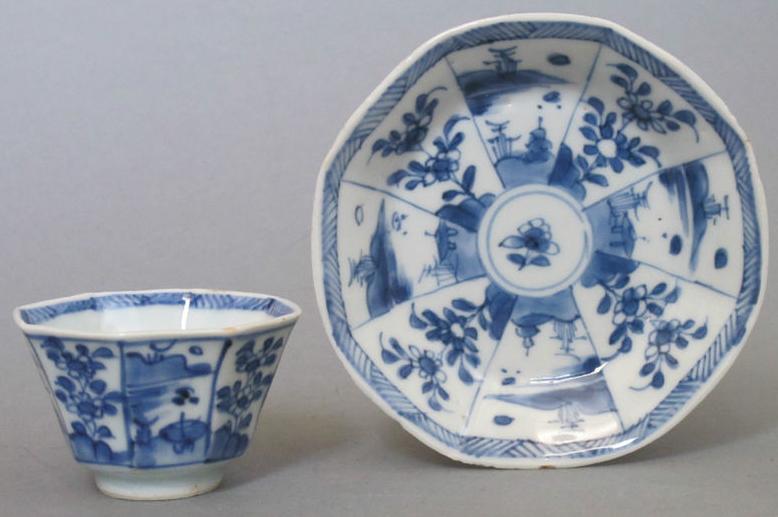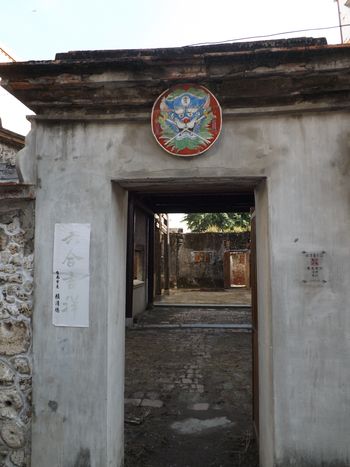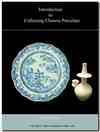Chinese Porcelain
Development influenced by economy and trends
Chinese porcelain had already been in existence far over a thousand years, and exported for about half a millenium, when European seafarers first discovered China when they were searching for the spice islands. That was during the Ming dynasty.
Re-discovered would be more appropriate, for the Venetian Marco Polo had been in China during the previous Yuan dynasty (1206~1367). He reached it by travelling over land through central Asia.
The Portuguese were the first to discover China by sea. Their ships reached the Far East in the Ming dynasty. At that time Chinese porcelain had already made the transformation from mostly monochrome to
polychrome wares. Blue and white porcelain had already been produced for a couple of hundred
years, and the Portuguese brought back ship loads of this commodity to Europe.
Blue and white (underglaze blue) porcelain was already a well developed and attractive product when European explorers set their eyes on them for the first time.
|
When those blue and white wares first arrived in European ports the Chinese porcelain had already been an export commodity to the Middle East for some time. Porcelain was first carried over land via silk road as early as the Tang dynasty (618-907). |
 Chinese Porcelain - cup and saucer |
|
Up to the Ming dynasty (1368-1644) China's porcelain production was actually mainly export
driven. However, during the Ming dynasty porcelain was also increasingly made for domestic use. Before blue and white porcelain emerged, celadon wares were one of the major ceramic categories exported. The porcelain used in China itself up to the Yuan dynasty was usually either plain, without decoration, or it was celadon, monochrome, or otherwise decorated in drab colors. Some of it had decorations that were scratched, carved or impressed in the clay, which would then appear with a darker shade of the same color in the fired glaze. |
The Rise of Jingdezhen
In the Yuan dynasty, when China was under Mongol rule, underglaze blue porcelain replaced celadon as the most favored export ceramics. This
shifted the importance of exporting kilns to Jingdezhen*, where the blue and white wares were at the time produced. Jingdezhen thus became the major porcelain production center.
This shift had a drastic effect on the industry as a whole. Up to then celadon and monochrome wares were manufactured in
huge
kiln systems, consisting sometimes dozens or hundreds
of individual kilns spread
over vast areas. These started now to decline while demand for the export of blue and white porcelain increased.
Only the Longquan kiln
system continued to flourish for some time in the Ming dynasty, paradoxically, due to increased export orders received for celadon when other celadon kilns had ceased production.
The time of the great kiln systems** of the Song and Yuan
dynasties was over.
Early records mention that the Mongol ruling class preferred metal table wares over porcelain, thus it must be assumed that most of the blue and white porcelain of the time was produced for export.
* Jingdezhen = Jingde Town in Jiangxi province
** Kiln system = There were sometimes dozens or hundreds of individual kilns producing similar wares as the main kiln. One of the largest was the Jun kiln system; the kilns producing jun wares were spread over a vast area from Southern Mongolia down to the Changjiang (Yangtse river).
The taste of new foreign buyers, mainly the Europeans arriving in the 16th century, caused the domestic porcelain production to
reach new heights during the late 16th and following centuries. As a result Chinese porcelain exports experienced a major shift towards buyer oriented
designs. Before that, much of the porcelain for domestic use in China had the same designs as the export wares.
With the new importance of its blue and white wares, Jingdezhen became now even more important, and the Ming dynasty imperial government designated a kiln at Jingdezhen as the official kiln (or imperial kiln) specifically to produce the ceramics required by the palace. That kiln retained this position until the end of the Chinese empire.

Jingdezhen became the mainstream production center, making porcelain of a higher quality than any other kilns. Most other kilns were relegated to manufacturing secondary or inferior quality wares for the general population. Only a few, like the Dehua kiln for example, were able to keep in step with Jingdezhen, producing both low and high-end wares.
History of Chinese Porcelain & Ceramics
"History" means here how and why Chinese historical events affected production, and the progress of ceramic development.
Some kilns still active today are known to have produced ceramics over 2000 years ago. Not difficult to imagine, that the historical developments in the land that today is called China did influence at times (or rather many times) the development of ceramics. Historical events sometimes affected ceramics production in quite a severe manner. However, there is no need to mention here details of any of the dynasties in the more distant past.
During
the Tang, Song and Yuan dynasties (see 'History Timeline') Chinese kilns were busy filling
domestic and overseas demand for ceramics.
|
Development of new production methods, decorations, etc. went hand in hand with the population's prosperity, which these activities provided during those times. The Ming and Qing dynasties present many examples regarding events that affected production and export of Chinese ceramics, like actual historical events: piracy, civil war, fall and
change of dynasties, opium wars, rebellions, etc. |
When
the Mongols lost their clout over China towards the end of the Yuan
dynasty, underglaze blue and white decorations of porcelain were
already well developed, although probably not yet the mainstream of
domestic ceramics. Much of the blue and white ceramics were exported.
In the China of those days only the affluent classes or nobility were
able to afford these.
During the reign of the first emperor of the Ming dynasty, Hongwu, the first ban of maritime trade was slapped on the empire by the palace. This was not the only time, however. What usually is called the Ming ban in the West was only the last one, noted for the way it affected the trade with Europe, especially during the late Ming dynasty.
Then, shortly after the Ming dynasty was overthrown and the new Qing court had itself established, another sea prohibition was proclaimed. During this time the inhabitants were forced to move inland, away from the coast. The purpose of this was mainly to fend off the remaining Ming loyals, especially their fleet under the command of Zheng Chenggong (aka Koxinga), operating in coastal areas from their base in Formosa (Taiwan). This was in order to prevent that they could get a hold on settlements or populations located in coastal areas.
During the ban of the late Ming dynasty some porcelain was still smuggled out in ships. However, the Qing ban interrupted the trade completely, so that even the Dutch Eastindia Company (VOC), which at the time was dominating almost all foreign trade in the region, was forced to turn to Japan for supplying the required export porcelain for Europe.
This was the last such ban in imperial China. It was finally lifted during the early Kangxi reign (in 1684), after the Qing government successfully routed the last resistance in Taiwan. The Dutch Eastindia Company resumed trading with China without delay.
Events affecting Chinese Porcelain Production and Export
- Song/Yuan dynasty - presumably earliest moves (emigration) of Chinese potters to SE Asia
- Ming bans - Chinese potters emigrate to Vietnam after their livelihood was affected by Ming sea bans (no export)
- Export production moves partially to Vietnam, Thailand, etc.
- Qing ban and its lifting (in 17th century) - Chinese exports to Europe stop
- Export porcelain from Japan replaces Chinese exports until the ban is lifted
- After lifting of ban China quickly regains position in view to porcelain exports to Europe
-
Japans Bakufu government closes the country to all foreigners (17th~19th century) - the Dutch Eastindia Company (V.O.C) has a monopoly for exporting Japanese porcelain from Deshima
- Limited trade between China and Japan
Other events affecting production and/or export (#Chinese porcelain):
- Piracy
- Opium wars
- Taiping rebellion
Home » Chinese Porcelain
Last update: 8. Aug. 2024

